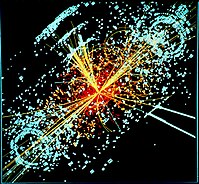
Photo from wikipedia
The exciting possibility of detecting supernova, solar, and atmospheric neutrinos with coherent neutrino-nucleus scattering detectors is within reach, opening up new avenues to probe new physics. We explore the possibility… Click to show full abstract
The exciting possibility of detecting supernova, solar, and atmospheric neutrinos with coherent neutrino-nucleus scattering detectors is within reach, opening up new avenues to probe new physics. We explore the possibility of constraining nonstandard coherent neutrino-nucleus scattering through astrophysical neutrinos. Sensitivity bounds on the mass and coupling of the new mediator are obtained by inspecting the modifications induced by the new interaction on the recoil rate observable in the upcoming RES-NOVA and DARWIN facilities. Under the assumption of optimal background tagging, the detection of neutrinos from a galactic supernova burst, or one-year exposure to solar and atmospheric neutrinos, will place the most stringent bounds for mediator couplings g ≳ 10 − 5 and mediator masses between 1 and 100 MeV. A similar, but slightly improved, potential to COHERENT will be provided for larger mediator masses. In particular, RES-NOVA and DARWIN may potentially provide one order of magnitude tighter constraints than XENON1T on the mediator coupling. Nonstandard coherent neutrino-nucleus scattering may also force neutrinos to be trapped in the supernova core; this argument allows us to probe the region of the parameter space with g ≳ 10 − 4 , which is currently excluded by other coherent neutrino-nucleus scattering facilities or other astrophysical and terrestrial constraints.
Journal Title: Physical Review D
Year Published: 2021
Link to full text (if available)
Share on Social Media: Sign Up to like & get
recommendations!